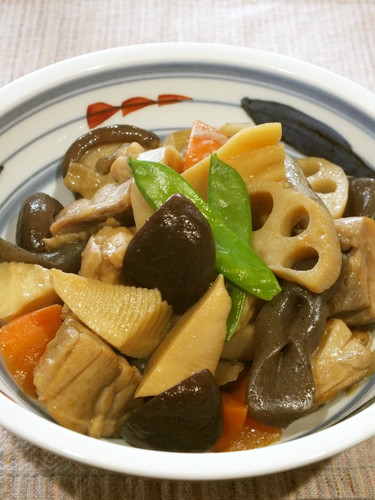
is a mix of vegetables such as Renkon (lotus root) and carrots, Konnyaku and chicken boiled in strongly flavored broth with soy sauce and sugar. The dish is originally from the southern part of Japan, in the Fukuoka region of Kyushu island, however, it has spread all over Japan.
Chikuzenni is an ordinary Nimono dish (boiled and seasoned vegetables) for everyday, but also a big part of Osechi Ryori, Japanese New Year’s cuisine. Strongly seasoned Chikuzenni is perfect for Osechi Ryori which is designed to last at least 3 days so house wives don’t have to cook in the beginning of new year (so they say).
Chikuzenni is also a very good Osechi dish because you can cook all the vegetables in one pot. Each vegetable in traditional Nishime (a different term for boiled and seasoned vegetables) is cooked and seasoned separately. So Chikuzenni is an easier version of Nishime, and that works for the busiest time of the year in Japan. That said, you still have to prepare each vegetable in its proper way: shaping Konnyaku into twisted ropes, cutting carrots into plum flowers, etc. It is not hard at all, but it requires some time and patience. It is a special dish to celebrate a new year, so we like to put some effort and thought into the dish, not just slapping ingredients together (we do enough of that all year).
There are a lot of vegetables you may not be familiar with in this dish. If there is no Japanese grocery store nearby to buy them, try other Asian stores, as they may likely carry most of ingredients.
Chikuzenni
Ingredients :
8 dried Shiitake mushrooms
8 snow peas
1 block Konnyaku
1 large carrot
1 Takenoko (Bamboo Shoot), boiled, cut into pieces 1" thick 2" long
5 oz Renkon (Lotus Root), boiled, sliced 1" thick
1 chicken breast or 2 thighs, cut into 2" pieces
1 Tbsp oil
2 1/2 cups Dashi
4 Tbsp sugar
5 Tbsp soy sauce
3 Tbsp Sake
3 Tbsp Mirin
Instructions :

Hydrate dried Shiitake mushrooms in water in a medium bowl.
Blanch the snow peas in boiling water or Dashi with a pinch of salt.
Cut Konnyaku into 1/2" thick pieces, make 1/2" slit in the middle of the piece, and thread an end through the hole to make like a twisted rope (you can blanch them as well if you don't like the smell).
Cut carrot into 1/2" thick rounds, then cut with a flower shaped cookie cutter (please watch the video to see how to cut for a 3-D effect).
In a large pot, add oil and heat at medium heat. When the oil becomes hot, add chicken pieces and cook until brown (no need to cook through). Add all vegetables except the Shiitake and the snow peas and cook and stir for a couple of minutes. Then add Shiitake and Dashi, cover, and cook for 15-20 minutes until vegetables become soft.
Add sugar, soy sauce, Sake, and Mirin, stir, and cook another 15-20 minutes uncovered.
Remove from heat and let it continue to cook, covered, so the meat and vegetables absorb flavor from the soup. Serve with snow peas as garnish.










